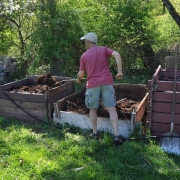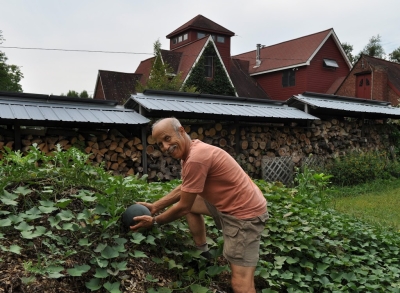Compost and Cucurbits
You’d think, this time of year, that all I’d be doing is sowing seeds and transplanting small and large plants. I am. But I’m also turning compost piles, getting ready to use that “black gold” this autumn. Why now? So the stuff has time to mellow and to make space for new compost piles that will be built from now through autumn.
Here’s my compost routine: All summer and into autumn I fill empty compost bins with hay, wood shavings, horse manure, weeds, kitchen waste, and old garden plants along with some sprinklings of soil, limestone, soybean meal (if extra nitrogen is needed), and sufficient water to moisten the ingredients. When a bin is full, which means loaded up about 5 feet high, it gets covered with a sheet of EPDM rubber roofing material to keep excess moisture out and to seal in whatever moisture is within. A numbered label on each pile gets recorded to remind me when the pile was completed, what went in, and, with the help of a 2-foot-long thermometer, how much heat, if any, was generated.
Fast forward to today. I’m flipping over the contents of two compost bins, one completed last July and the other last August, into empty adjacent bins. Turning over the contents lets me see how the compost
has fared over the past 10 months; some piles might still be a bit raw, others are just about finished and ready for use. No matter, I don’t need any compost yet.
No rule that says compost piles have to be turned at all. I do it because I like to see what’s been going on and so I can make slight adjustments, as needed. Sometimes a little more water is needed. Turning the pile also gives me the opportunity to break up any clumps of material and render the finished pile more uniform.
One of the piles I turned this spring had so much undecomposed hay in it that I sprinkled on some soybean meal as I turned it. Even that wasn’t one-hundred percent necessary; the high nitrogen soybean meal just speeds decomposition. Leave any organic materials (that is, something that is or was living) piled together long enough, with a bit of moisture, and it will definitely turn to compost. As my bumper sticker reads: “Compost happens.”
————————————————–
One more reason for turning and organizing all of last year’s compost piles is to make space for growing melons and squashes. My vegetable garden is very intensively planted, with 3 foot wide beds packed tight with one or more vegetables growing together or in sequence, perhaps even trained skyward to get more out of the space. The long, sprawling vines of melons and squashes don’t fit into this scheme of things.
The compost bins — 4 foot by four foot by 3 to 4 foot high cubes — are perfect for these vines. Three or 4 plants poked into the rich compost through holes made in the rubber roofing can sprawl to their hearts’ content, spreading out to cover the tops of the bins and then, if they like, draping down to the ground, even creeping along the ground if that’s their whim.
Melons and squashes thrive in rich soil, and my plants roots couldn’t find themselves in a richer soil than the pure compost within the bins. Plenty of water is needed to plump up the fruits; the compost clings to enough water so that watering is hardly necessary.
————————————————–
The only melon that does not get planted on a compost bin is watermelon. But even watermelon doesn’t go in the garden. It goes onto a pile of wood chips or leaves I had dumped here last autumn and winter.
In contrast to the muskmelons, honeydews, and cantaloupes, all which bear a few fruits and then give up the ship, watermelon vines just keep bearing and bearing until stopped by frost or short days. I’ll
need to get into the compost bins before frost and short days; muskmelons, honeydews, and cantaloupes will be gone and out of the way but watermelon would not.
Also, watermelons don’t demand a rich soil. “Soil” that’s either partially decomposed leaves or wood chips is poor in nutrients, to say the least. So poor that when I plant in the leaf or wood chip pile, I scoop out a generous hole and fill it with compost to get the plant off to a good start. During the growing season, I’ll occasionally dose the watermelon plants with some soluble fertilizer.
All kinds of melons thrive in heat, in the air and in the ground. Freshly turned compost and old leaves or wood chips aren’t static. They are decomposing and, in doing so, generating some heat. All of which makes for good crops of good-tasting melons.







